I am working with the STM32F767ZIT6. At the moment I am exploring the QuadSPI peripheral. After setting up the peripheral with the following configuration I noticed some undesired behavior of the data lines following the dummy cycles.
// PRESCALER = 160 -> 1 MHz.
// FTHRES = 3 -> 4 Byte threshold.
// FSEL = 1 -> Flash 2 selected.
QUADSPI->CR =
(160UL << QUADSPI_CR_PRESCALER_Pos)
| ( 3UL << QUADSPI_CR_FTHRES_Pos)
| QUADSPI_CR_FSEL;
// FSIZE = 31 -> 2^32 Bytes.
// CSHT = 7 -> Chip select 8 Cycles
// CKMODE = 0 -> SPI Mode 0.
QUADSPI->DCR =
(31UL << QUADSPI_DCR_FSIZE_Pos)
| ( 7UL << QUADSPI_DCR_CSHT_Pos);
// FMODE = 0 -> Indirect Write Mode.
// IMODE = 3 -> Four Lines.
// ADMODE = 3 -> Four Lines.
// ABMODE = 3 -> Four Lines.
// DMODE = 3 -> Four Lines.
// ADSIZE = 2 -> 24 Bit.
// ABSIZE = 2 -> 24 Bit.
// DCYC = 8 -> 8 Dummy Cycles.
// INSTRUCTION = 0x48.
QUADSPI->CCR =
( 3UL << QUADSPI_CCR_DMODE_Pos)
| ( 3UL << QUADSPI_CCR_ABMODE_Pos)
| ( 3UL << QUADSPI_CCR_ADMODE_Pos)
| ( 3UL << QUADSPI_CCR_IMODE_Pos)
| ( 2UL << QUADSPI_CCR_ADSIZE_Pos)
| ( 2UL << QUADSPI_CCR_ABSIZE_Pos)
| ( 8UL << QUADSPI_CCR_DCYC_Pos)
| (72UL << QUADSPI_CCR_INSTRUCTION_Pos);
QUADSPI->DLR = 64;
QUADSPI->ABR = 0xAABBCCUL;
QUADSPI->AR = 0x123456UL;
QUADSPI->CR =
QUADSPI->CR
| QUADSPI_CR_EN;
- Send Instruction (1 Byte 72)
- Send Address (3 Bytes 0x123456)
- Send Alternate (3 Bytes 0xAABBCCDD)
- Send Dummy (8 Cycles)
- Send Data (64 Bytes 0x12345678, 0xFFFFFFFF ... 0xFFFFFFFF)
So after the first glance everything looks good. But there's one thing that could cause trouble and make me uncomfortable. After the 8 dummy cycles the data lines changing their state, according to the first data byte high nibble, on the rising edge of the clock. But I am using SPI mode 0 so the slave is sampling the data lines on the rising edge of the clock. So there is a chance that the first 4 bits after the dummy cycles gets corrupted.
Did I made some configuration mistake, is it a bug or is this normal behavior and I am wrong?
- Quad SPI description p.407
- Quad SPI registers p.423
EDIT: After looking into the errata I probably found the problem.
2.12 QUADSPI peripheral limitations
2.12.1 First nibble of data is not written after a dummy phase Description
The first nibble of data to be written to the external Flash memory is lost in the following conditions:
The QUADSPI is used in the indirect write mode
And at least one dummy cycle is used
Workaround
Use alternate-bytes instead of a dummy phase in order to add a latency between the address phase and the data phase. This works only if the number of dummy cycles corresponds to a multiple of 8 bits of data. Example: To generate: – 1 dummy cycle: send 1 alternate-byte, possible only in 4 data line DDR mode or Dual-flash SDR mode – 2 dummy cycles: send 1 alternate-byte in 4 data line SDR mode – 4 dummy cycles: send 2 alternate-bytes in 4 data line SDR mode or send 1 alternate-byte in 2 data line SDR mode – 8 dummy cycles: send 1 alternate-byte in 1 data line SDR mode
But the workaround is not working for me because my slave needs the 8 dummy cycles to switch between input/output mode. If I use the alternate byte instead of the dummy cycles there is a chance that the master and slave driving the data lines concurrent which could cause some hardware damage! So is there a magic trick to getting around this problem?
